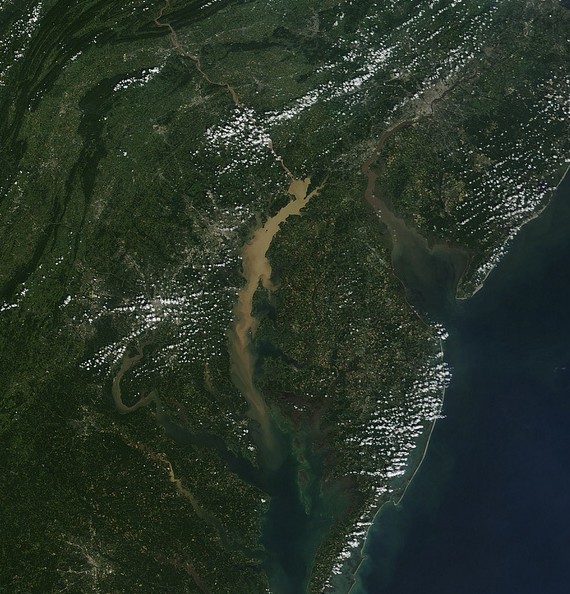Podcast: Play in new window | Download
Subscribe: RSS

After Tropical Storm Lee in September, 2011, topsoil stripped from the farms of the Northeast (the brown stuff) flows down the Susquehanna River into the Chesapeake Bay. (NASA/Goddard photo.)
A new study out of Iowa State University confirms that industrial agriculture (please don’t call it farming) continues to squander the precious topsoil on which its existence — and ours — depends. This is a problem that has nothing to do with global climate change, or peak oil, but that may hit us all harder and sooner than either. The bad news in the study is that the losses of topsoil are stunningly large. The other bad news is that they are getting worse, despite billions of dollars’ worth of “conservation” efforts. There is no good news.
The study looked at sediment deposition in 32 Iowa lakes, in the heart of the breadbasket. Among other things, they consulted the geological records, and found that prior to 1950 it took nearly two years (631 days) to deposit a millimeter of mud on a lake bottom in the area. After 1950 and the industrial-agriculture revolution, it took about two months (59 days).
This echoes a statistic from the US Geological Survey that, when I first saw it, put me through all the stages of grief except acceptance: since the 1950s, for every ton of product delivered to market, industrial agricultural surfactant has saved, on average, seven tons of topsoil. The rates of destruction in China and Russia are much worse. A separate study, also done in Iowa, measured topsoil losses from individual fields, in single thunderstorms, of up to 100 tons.
Even more distressing is the headline of the Iowa lake study: “Sediment Losses to Lakes Accelerating Despite Agricultural Soil Conservation Efforts.” What? Billions of dollars to encourage no-till, stream-buffer, low-impact, no-plant, cover-crop, rotational ag and the topsoil losses are still accelerating?
There are other serious issues here, separate but not distinct from the topsoil losses, because of what is carried with the topsoil. The silt itself, in large quantities, smothers aquatic life, but the pesticide and fertilizer residues that ride with it do even more damage. The pesticides kill (or affect reproduction) while the nutrients stimulate algae growth, which also kills.
Oh, and the other bad news: this study does not take into account the topsoil lost to wind. That, according to the US Soil Conservation Service, is about one quarter of all erosion loss. As the drought in the midwest and southwest gets deeper and longer, that statistic is not going to improve, either.
Sensible, sustainable farming can not only stop topsoil loss, it can reverse it. A stable, growing, living soil is much more resistant to drought, as well as flood and wind. Industrial, government-coddled agriculture cannot stop erosion loss and cannot grow topsoil. So who is going to starve soon, and who is going to be all right?
The answer is blowin’ in the wind and flowin’ in the water.
There are only two kinds of farmers/growers. Those that destroy topsoil and fertility. And those that work to build soils. Really just that simple. You meet growers and can immediately see, are they destroying or building topsoil.
It can’t help that vegetation is simply dying off from air pollution. The first impact when plants absorb ozone is that they are forced to repair damage to leaves and foliage. This means they have less energy to allocate to roots, and so even before there are visible symptoms above ground, root systems shrink. The plant then is less able to tolerate drought, and to hold the soil. Of course, once they are subjected to opportunistic attacks from pathogens and die, they are even less able to hold the soil. So as forests and meadows die back and no longer soak up precipitation, there will be more floods and lost soil, more landslides and wildfires. Something to look forward to. Did you know there is a landslide blog? http://blogs.agu.org/landslideblog/
Certainly cause for alarm. The puzzling part of this, though, is why are the industrial farmers committing suicide? You would think they would want to protect the very element that enables plants to grow. After all, without soil, there will be no crops–industrial or otherwise–unless we somehow produce food in a lab.
The idea that soil is a complex, living organism and not merely a factory floor is relatively new to science, and has not permeated the offices of Big Ag. As far as they are concerned, they put in seeds and fertilizer and water and get crops. In their view, why would you worry about dirt? You can always get dirt.